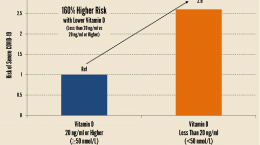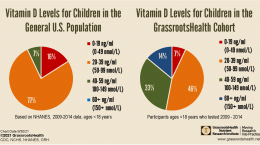Published on April 27, 2022
Study identifies what makes children more susceptible to severe COVID-19; each risk factor listed is related to vitamin D deficiency
Key Points
- Among children with a vitamin D level below 20 ng/ml (50 nmol/L), 31% had moderate to severe COVID-19 symptoms, compared to only 18% with moderate symptoms (none classified as severe) for those with vitamin D levels of 20 ng/ml or higher
- A study by Graff et al. analyzed data from 454 SARS-CoV-2 positive children to determine what factors presented the greatest risk for severe COVID-19 among children and young adults under the age of 21
- Each of the risk factors identified were related to vitamin D deficiency
 Several studies have now been published on vitamin D and children with COVID-19, with one previously reviewed study finding increased COVID-19 disease severity among children with lower vitamin D levels. In fact, among children with a vitamin D level below 20 ng/ml (50 nmol/L), 31% had moderate to severe COVID-19 symptoms, compared to only 18% with moderate symptoms (none classified as severe) for those with vitamin D levels of 20 ng/ml or higher. Additionally, 46% of the children with higher vitamin D levels were asymptomatic, compared to only 10% of those with lower vitamin D levels.
Several studies have now been published on vitamin D and children with COVID-19, with one previously reviewed study finding increased COVID-19 disease severity among children with lower vitamin D levels. In fact, among children with a vitamin D level below 20 ng/ml (50 nmol/L), 31% had moderate to severe COVID-19 symptoms, compared to only 18% with moderate symptoms (none classified as severe) for those with vitamin D levels of 20 ng/ml or higher. Additionally, 46% of the children with higher vitamin D levels were asymptomatic, compared to only 10% of those with lower vitamin D levels.
What are the Risk Factors for Severe COVID-19 in Children (Besides Vitamin D Deficiency)?
While children tend to have less risk for severe COVID-19 illness than adults, there are certain factors that make these children more susceptible to getting severe COVID-19. In order to identify these risk factors, Graff et al. analyzed data from 454 SARS-CoV-2 positive children to determine what factors presented the greatest risk for severe COVID-19. Participants were less than 21 years old, with an average age of 11 years; 55% of the participants were Hispanic, 23% were non-Hispanic Whites, and 5% were non-Hispanic Blacks.
Of the children who tested positive for SARS-CoV-2, 69% were symptomatic (mostly presenting with fever, cough, and congestion or runny nose), while 18% were asymptomatic. 66 children (21%) were admitted to the hospital for COVID-19, of which 55% went on respiratory support and 17% needed critical care. Among those admitted, the average length of stay was 3 days, 5 children required readmission, one was readmitted twice, 3 children ended up with venous thromboembolism, and one child died due to complications of extracorporeal membrane oxygenation (ECMO).
The children requiring hospital admission for symptomatic COVID-19 were more likely
- infants (0-3 months old) and young adults (older than 20 years)
- presenting with multiple comorbidities
- to present with comorbidities of pulmonary, gastrointestinal, endocrine, neurologic, and psychiatric disease(s)
- to have immunocompromising conditions
- to have been born prematurely
- to have asthma, obstructive sleep apnea, diabetes/prediabetes
- obese (which resulted in more than twice the odds of admission) or severely obese (which resulted in almost 5 times the odds of admission)
- to have elevated c-reactive protein (CRP) levels
Each of these Risk Factors is Related to Vitamin D Deficiency
While vitamin D deficiency itself is a risk factor for severe COVID-19 disease, as demonstrated in multiple studies, it is also related to each of the conditions listed above.
Infants: 70% or more of all infants are not getting the recommended amounts of vitamin D, despite recommendations from the American Academy of Pediatrics
Young Adults: As teens continue to grow, their demand for vitamin D increases. There is a 4-fold increase in the proportion of children with levels below 20 ng/ml, from 6% for ages 0-4 years, to 25% for ages 13-17 years
Comorbidities: Vitamin D deficiency is related to pulmonary, gastrointestinal, endocrine, neurologic, and psychiatric disease
Immune Health: Vitamin D is essential for proper immune functioning
Prematurity: More than 80% of pregnant women are vitamin D deficient, and women with vitamin D deficiency during pregnancy are much more likely to have a preterm birth. Babies born to women with vitamin D deficiency will also be deficient, with an increased risk for impairment in immune function, brain development, and skeletal development, among other things. Health conditions in the child that have been associated with prenatal vitamin D deficiency include asthma, ear and lung infections, autism, type 1 diabetes and other autoimmune conditions, and an increased risk for certain cancers and cardiovascular disease later in life.
Obesity: Evidence also shows that vitamin D levels are greatly affected by obesity. The more fat a person has on their body (the higher the BMI), the more likely they are to have vitamin D deficiency, and their need for vitamin D increases. In fact, the amount of vitamin D needed on a daily basis to achieve a vitamin D level of 40 ng/ml (100 nmol/L) can vary by as much as 3 times the amount, depending on BMI.
A video recently released, titled REPORT: 9 out of 10 CHILDREN with COVID in ICU had THIS health condition…, reviews findings from North Carolina discussing the correlation between obesity and COVID-19 severity among children hospitalized with COVID-19. These findings are similar to others showing both vitamin D deficiency and obesity as risk factors for severe COVID-19 among adults.
CRP: Studies have associated higher vitamin D with lower levels of inflammation and CRP, in diseases such as in cardiovascular disease, psychiatric disorders, and diabetes. Research is also showing a relationship between higher CRP levels and an increased risk for and severity of COVID-19
Vitamin D is an Easily Modifiable Factor to Help Improve Disease Outcomes. Measure Your Level Today!
 Having and maintaining healthy vitamin D levels and other nutrient levels can help improve your health now and for your future. Choose which additional nutrients to measure, such as your omega-3s and essential minerals including magnesium and zinc, by creating your custom home test kit today. Take steps to improve the status of each of these measurements to benefit your overall health. With measurement you can then determine how much is needed and steps to achieve your goals. You can also track your own intakes, symptoms and results to see what works best for YOU.
Having and maintaining healthy vitamin D levels and other nutrient levels can help improve your health now and for your future. Choose which additional nutrients to measure, such as your omega-3s and essential minerals including magnesium and zinc, by creating your custom home test kit today. Take steps to improve the status of each of these measurements to benefit your overall health. With measurement you can then determine how much is needed and steps to achieve your goals. You can also track your own intakes, symptoms and results to see what works best for YOU.
Enroll in D*action and Test Your Levels Today!





